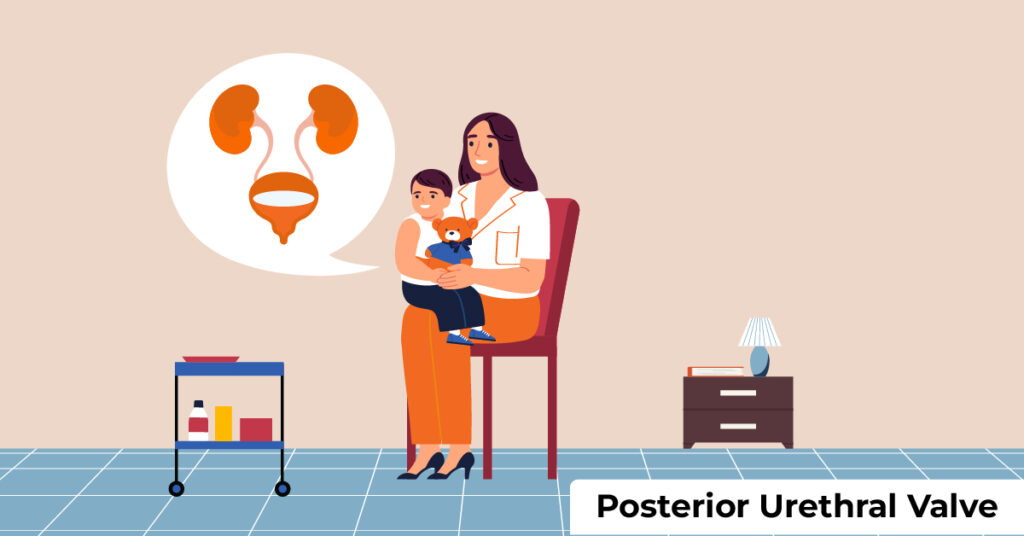
QUES 1 WHAT ARE POSTERIOR URETHRAL VALVES?
Ans. Posterior urethral valves, also called PUVs, are a rare birth defect that happens only in infants assigned male at birth. Babies with posterior urethral valves have a fold of tissue in the urethra that blocks urine (pee) from flowing out of the bladder. The urethra is the tube that drains urine from your bladder and carries it out of your body.
In children with this condition, the urethral valves have a very narrow opening that prevents urine from flowing out of the body completely. Urine then remains in the body and can damage the organs of the urinary tract, including the urethra, bladder, kidneys and ureters. The ureters are the tubes that carry urine to your bladder from your kidneys.
QUES 2 WHAT ARE THE DANGERS OF POSTERIOR URETHRAL VALVES?
Ans. If a child with posterior urethral valves doesn’t get an early diagnosis, severe damage can happen to the various parts of the urinary tract. These organs can swell with urine, harming the tissues.
QUES 3 HOW COMMON ARE THEY?
Ans. The condition affects about 1 in 5,000 infants globally. The U.S. incidence is estimated to range from 1 in 5,000 to 1 in 8,000.
QUES 4 WHAT CAUSES POSTERIOR URETHRAL VALVES?
Ans. Posterior urethral valves are a rare condition that affects babies assigned male at birth. Researchers aren’t sure why PUVs happen, but the condition occurs in the early stages of Fetal Development.
QUES 5 WHAT ARE THE SYMPTOMS OF POSTERIOR URETHRAL VALVES?
Ans. Symptoms of posterior urethral valves can range from moderate to severe. The most common symptom is a urinary tract infection.
- Symptoms can include:
- Urinary tract infections.
- Poor weight gain in infants.
- Painful urination (also called dysuria).
- Difficulty urinating.
- Kidney failure.
QUES 6 HOW ARE POSTERIOR URETHRAL VALVES DIAGNOSED?
Ans. An ultrasound to diagnose a posterior urethral valve condition before a baby is born. Treating a baby before birth only happens when the condition is very severe and is causing problems for your baby.
After birth, your provider will also use ultrasound to monitor the condition. If your baby’s healthcare provider suspects he may have PUVs, they’ll request a series of tests that include:
Renal ultrasound: An ultrasound of the kidneys and urinary tract can detect a mass or obstruction.
Voiding cystourethrogram: A catheter is placed in the bladder, and contrast is instilled. Then, an X-ray of the urinary tract lets your provider see a direct image of the bladder and ureters.
Cystoscopy: This test uses a small, flexible tube with a light and a camera lens at the end to look inside the urinary tract.
Blood test: A blood test can help to determine how well your child’s kidneys are working.
If your child’s provider diagnoses posterior urethral valves, they’ll work with you to develop the most suitable treatment plan for your child.
QUES 7 HOW ARE POSTERIOR URETHRAL VALVES TREATED?
Ans. Treatment for posterior urethral valves depends on the severity of your child’s condition. The amount of damage that can happen to your child’s urinary tract depends on how badly the urethra is blocked and how long it takes to diagnose the condition.
The most common treatment for posterior urethral valves is a minor surgical procedure to remove the obstructing valve. Children with a more severe case of PUVs may also need to use a catheter to empty their bladder at times. Your child’s provider may suggest a vesicostomy, a surgical procedure to create small opening in the bladder made through the abdomen, to help with the flow of urine.
In some children with severe PUV, the urine will reflux — back up into the kidneys — causing gradual damage to the kidneys and leading to kidney failure. Your child will need urodynamic testing to evaluate the bladder and monitor for any reflux.
Your provider may also prescribe medication to treat urinary tract infections or to relax the bladder muscle.
QUES 8 WHAT ARE THE COMPLICATIONS OF POSTERIOR URETHRAL VALVES?
Ans.
- Vesicoureteral reflux, which means that the urine goes backward into the body
- A bladder that doesn’t empty completely, also called urinary retention
- Stretched-out kidneys (hydronephrosis).
- Kidney failure
- Prevention
QUES 9 CAN I PREVENT POSTERIOR URETHRAL VALVES?
Ans. Posterior urethral valves develop before a child is born. You can’t prevent them from happening. Your provider may be able to diagnose this condition before birth. Treatment usually happens immediately after birth.
